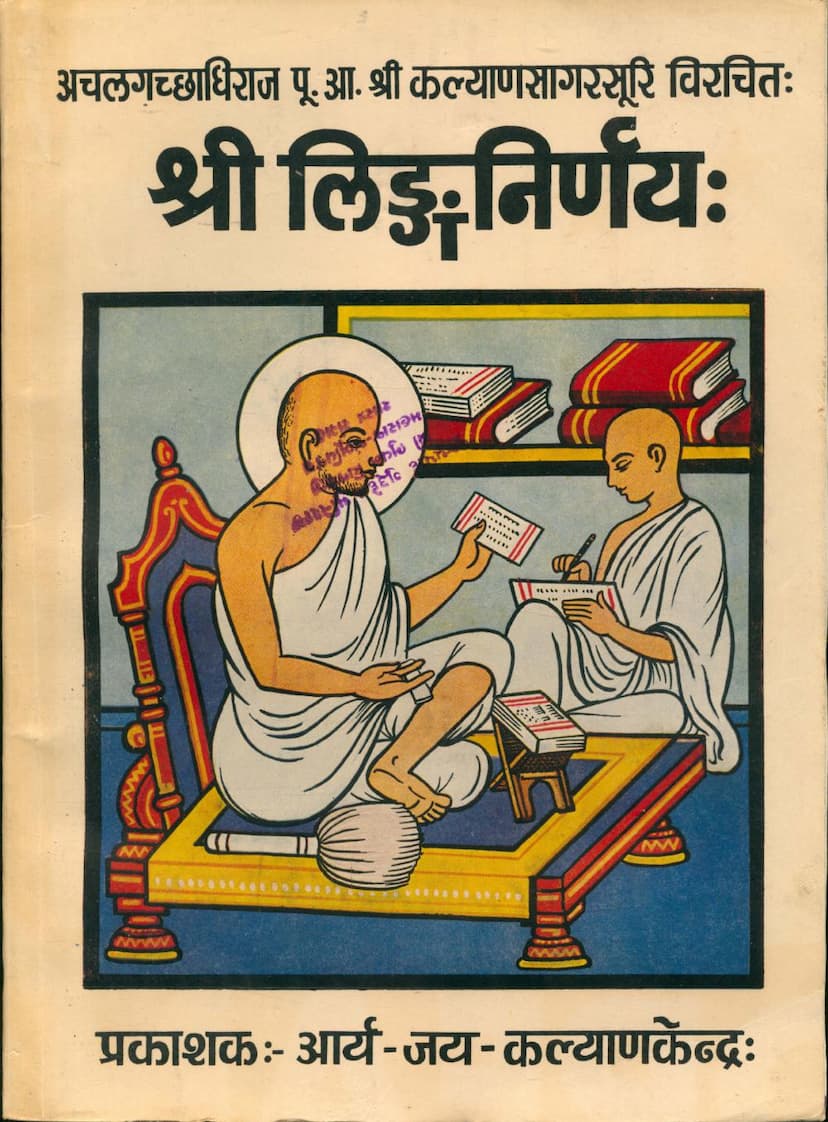Lingnirnayo Granth
Added to library: September 2, 2025

Summary
Here's a comprehensive summary of the Jain text "Lingnirnayo Granth" by Kalaprabhsagar, based on the provided pages:
Book Title: Lingnirnayo Granth (लिंगनिर्णयः ग्रंथ) Author: Kalaprabhsagar (कलाप्रभसागर) Publisher: Arya Jay Kalyan Kendra (आर्य-जय-कल्याणकेन्द्र)
Overall Purpose and Content:
The "Lingnirnayo Granth" is a significant Jain grammatical text that aims to resolve ambiguities regarding the gender (linga) of Sanskrit words. It specifically focuses on words found in the renowned lexicon "Abhidhan Chintamani Kosha" (अभिधानचितामणिकोष) by Acharya Hemchandrasuri, where the gender of certain words is uncertain or can be used in multiple genders. The book provides a systematic approach to determining the correct or conventionally accepted gender of these words, thereby aiding in the accurate understanding and use of Sanskrit grammar within the Jain tradition.
Authorship and Lineage:
- Author (Compiler): Muni Kalaprabhsagar (मुनि कलाप्रभसागरजी), a disciple of Acharya Shri Gunsaagarsuri (आचार्य भ. श्री गुणसागरसूरि).
- Inspiration and Patronage: The publication and the underlying spirit of this work are attributed to the guidance and blessings of Acharya Shri Guṇasaagarsuri (आचार्य भ. श्री गुणसागरसूरि), the leader of the Achal Gachha. The work is dedicated to the legacy and teachings of Acharya Shri Kalyanasaagarsuri (आ. श्री कल्याणसागरसूरीश्वरजी म. सा.), who is considered the main author of the original "Lingnirnay" text.
- Scholarly Contributions: The text was compiled and edited by Muni Kalaprabhsagar. Key scholars involved in its realization include Mahopadhyay Pandit Vinaysagar (महोपाध्याय पंडित विनयसागर) and Pandit Navinchandra Doshi (पंडित नवीनचंद्र).
Key Themes and Approach:
- Resolution of Gender Ambiguity: The primary goal is to clarify the gender of Sanskrit words that have differing classifications in various dictionaries and grammatical traditions.
- Reliance on "Abhidhan Chintamani Kosha": The text specifically targets words mentioned in Hemchandrasuri's "Abhidhan Chintamani Kosha," serving as a commentary or supplement to it.
- Grammatical Foundation: It delves into the intricacies of Sanskrit grammar, particularly the rules and traditions of gender assignment (linganushasan).
- Emphasis on Achal Gachha Tradition: The book is a product of the Achal Gachha (अचलगच्छ) tradition, and the lineage of its spiritual leaders (Gachhadhipatis) is highlighted throughout the introductory sections.
- Scholarly Rigor and Research: The compilation involved extensive research, including the study of various manuscripts and consultations with scholars. The editors faced challenges in obtaining complete and accurate manuscripts, making the process of clarification and correction crucial.
- Accessibility: While rooted in classical grammar, the intention is to make this complex subject accessible and useful for students and scholars. The inclusion of a detailed vocabulary (Shabda Kosh) with Gujarati meanings further enhances its accessibility.
Structure and Content Breakdown:
- Introduction and Acknowledgements (Pages 2-10): These pages include auspicious greetings, dedications, acknowledgments to donors and supporters, a list of published works by Arya-Jay-Kalyan Kendra, and biographical sketches of prominent Acharyas of the Achal Gachha, particularly Acharya Shri Kalyanasaagarsuri.
- Author's Biography (Page 10, 21-34): A detailed biographical account of Acharya Shri Kalyanasaagarsuri is provided, outlining his birth, initiation, ascension to the Acharya and Yugapradhan positions, significant activities, travels, and contributions to Jainism and scholarship.
- Editorial and Publisher's Statements (Pages 12, 16-19): These sections explain the purpose of the publication, the mission of the Arya-Jay-Kalyan Kendra in preserving and propagating Jain literature, and the historical context of the project.
- Scholarly Introduction (Page 20): Pandit Harinarayan Mishra provides an introductory essay on the importance of grammar and the role of gender in language, highlighting the need for such a clarifying text.
- The "Lingnirnay" Text (Pages 54-107): This is the core of the book. It is divided into six "Kandas" (chapters), each systematically listing words and their determined genders, often referencing traditional authorities and sometimes offering original interpretations. The text includes Sanskrit verses that define the gender of numerous words.
- Errata (Shuddhipatraka) (Pages 35-38, 107): Corrected versions of some initial errors in the text are provided.
- Appendices (Parishisht):
- Appendix 1 (Page 51): An alphabetical index of specific names mentioned by the author, along with their page and verse references in the text.
- List of Donors (Page 53): A list of individuals and families who contributed to the publication.
Significance and Impact:
The "Lingnirnayo Granth" is valuable for its:
- Preservation of Linguistic Heritage: It helps in the accurate understanding and transmission of Sanskrit grammar, a vital component of Jain literature and philosophy.
- Scholarly Resource: It serves as a crucial reference for students, scholars, and anyone engaged in the study of Jain scriptures and Sanskrit linguistics.
- Contribution to the Achal Gachha's Literary Output: It is part of a larger effort by the Achal Gachha to preserve and promote ancient Jain texts.
- Practical Guidance: By resolving ambiguities, it offers practical guidance for correct composition and interpretation of Jain texts.
In essence, "Lingnirnayo Granth" is a meticulously researched and compiled work that bridges the gap in understanding gender in Sanskrit, specifically within the context of the rich lexicon of Hemchandrasuri, thereby contributing significantly to Jain grammatical scholarship.